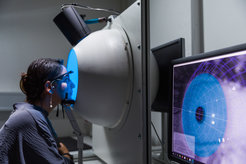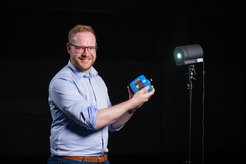AVA David Marr Medal for Max Planck Researcher Manuel Spitschan
Applied Vision Association (AVA) honors his pioneering work in fields of human vision and non-visual physiology
Max Planck Research Group Leader Manuel Spitschan at the Max Planck Institute für Biological Cybernetics has been awarded the David Marr Medal by the Applied Vision Association (AVA) for his pioneering insights into how light impacts human physiology. The AVA honors his work on melanopsin- and cone-mediated mechanisms which contribute to human visual perception, the pupillary light reflex, melatonin suppression, and circadian phase shifting. The medal will be handed over during the AVA Christmas Meeting, taking place at Royal Holloway, University of London in December 2023.
Manuel Spitschan's research focuses on the effects of light on human physiology and behaviour, in particular the interplay with the human biological clock, circadian rhythm, and sleep. Spitschan provides new insights into the fundamental properties of melanopsin, a light-sensitive photoreceptor only recently found in the human retina. Melanopsin contributes to visual functions, for example brightness estimation, and for non-visual tasks such as circadian phase-shifting.
Blue light shifts our inner clock

The rods and cones, the two most important photoreceptor types in our eyes, help us to see colors and shades. Some time ago, scientists have identified the function of another photoreceptor, the intrinsically photosensitive retinal ganglion cell (ipRGC). These photoreceptors are sensitive to blue light and help signal time of day to the brain.
When blue light hits the eye, the ipRGCs begin to fire fast due to the light-sensitive molecule melanopsin. The more photons the ipRGCs capture, and the stronger the signal generated by the photoreceptor, the more melatonin production gets suppressed.
"One of the hallmarks of our inner clock is the production of the hormone melatonin in the evening. Melatonin is associated with sleepiness," says Manuel Spitschan, who also holds a Rudolf Mößbauer Professorship at the Technical University of Munich as part of the ´MaxPlanck@TUM´ program. "When people are exposed to light at night or in the evening, the production of melatonin is suppressed. Disruption of our inner clock can affect our body´s functions, for example on metabolism and immune functions."
In his work, Spitschan combines a variety of cutting-edge research methods, including functional neuroimaging (fMRI), pupillometry, psychophysics, and neuroendocrine and circadian assessment. Two notable discoveries elucidated the role of the short-wavelength cones cones in controlling the size of the pupil, and in driving melatonin suppression.
Basic research with translation to human health and wellbeing

With basics findings in hand, Spitschan is starting to turn his attention to understanding how basic research can be translated to optimize light exposure for health and well-being. Last year, he contributed to a scientific consensus recommending for the first time, light levels that individuals should get during the day and night.
The findings of Spitschan’s research program are interesting to disciplines well beyond neuroscience, including architectural lighting design. Spitschan collaborates with architects and lighting specialists to find better solutions for getting the right light at the right time.
The AVA David Marr Medal will be presented at an official ceremony during the annual AVA Christmas Meeting at Royal Holloway, University of London, this December.

